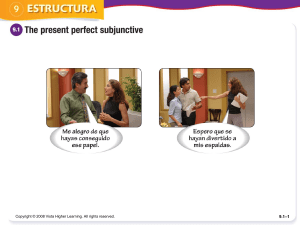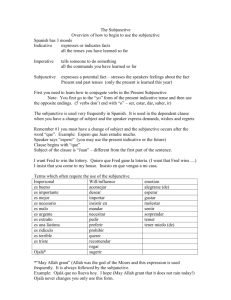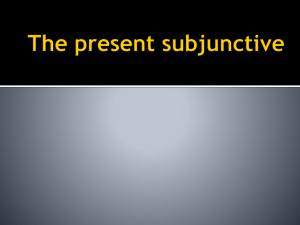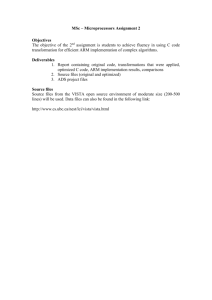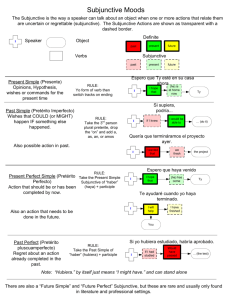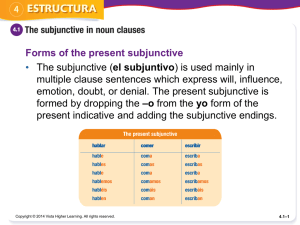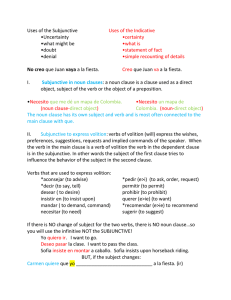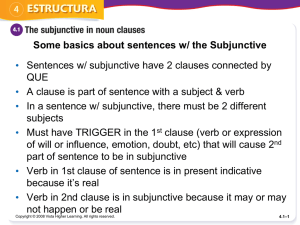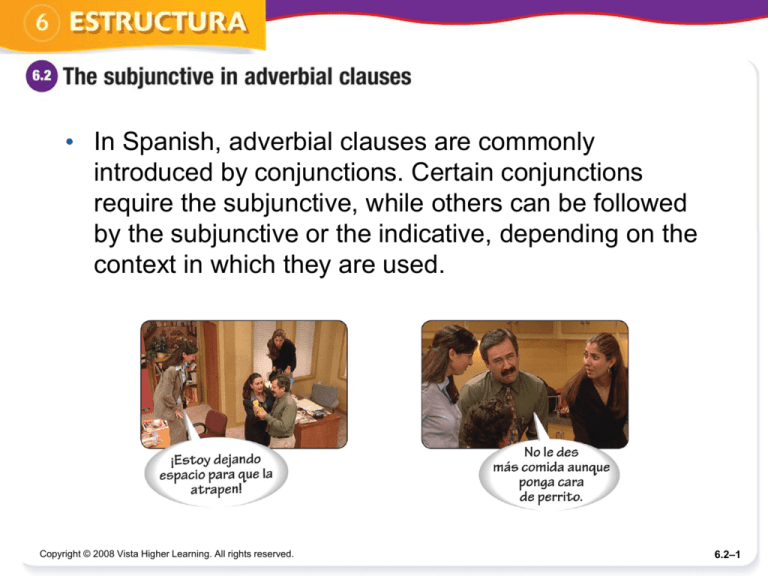
• In Spanish, adverbial clauses are commonly
introduced by conjunctions. Certain conjunctions
require the subjunctive, while others can be followed
by the subjunctive or the indicative, depending on the
context in which they are used.
Copyright © 2008 Vista Higher Learning. All rights reserved.
6.2–1
An adverbial clause (oración adverbial) is one that
modifies or describes verbs, adjectives, or other
adverbs. It describes how, why, when, or where an
action takes place.
To review the use of adverbs, see Manual de
gramática 6.4, p. 518.
Copyright © 2008 Vista Higher Learning. All rights reserved.
6.2–2
Conjunctions that require the subjunctive
• Certain conjunctions are always followed by the subjunctive
because they introduce actions or states that are uncertain or
have not yet happened. These conjunctions commonly express
purpose, condition, or intent.
MAIN CLAUSE
CONNECTOR
SUBORDINATE CLAUSE
Se acabará el petróleo en pocos años
a menos que
busquemos energías alternativas.
Copyright © 2008 Vista Higher Learning. All rights reserved.
6.2–3
El gobierno se prepara en caso de que haya una gran sequía el verano
que viene.
The government is getting ready in case there is a big drought in the
coming summer.
Iremos a las montañas el próximo miércoles a menos que haga mal tiempo.
We will go to the mountains next Wednesday unless the weather is bad.
Debemos proteger a los animales salvajes antes de que se extingan.
We should protect wild animals before they become extinct.
Copyright © 2008 Vista Higher Learning. All rights reserved.
6.2–4
• If there is no change of subject in the sentence, a
subordinate clause is not necessary. Instead, the
prepositions antes de, con tal de, en caso de, para,
and sin can be used, followed by the infinitive. Note
that the connector que is not necessary in this case.
Las organizaciones ecologistas trabajan para proteger los
arrecifes de coral.
Environmental organizations work to protect coral reefs.
Tienes que pedir permiso antes de darles de comer a los
monos del zoológico.
You have to ask permission before feeding the monkeys
at the zoo.
Copyright © 2008 Vista Higher Learning. All rights reserved.
6.2–5
Conjunctions followed by the subjunctive or the indicative
• If the action in the main clause has not yet occurred,
then the subjunctive is used after conjunctions of time
or concession. Note that adverbial clauses often come
at the beginning of a sentence.
Copyright © 2008 Vista Higher Learning. All rights reserved.
6.2–6
La excursión no saldrá hasta que estemos todos.
The excursion will not leave until we all are here.
Dejaremos libre al pájaro en cuanto el veterinario nos diga
que puede volar.
We will free the bird as soon as the vet tells us it can fly.
Aunque me digan que es inofensivo, no me acercaré al perro.
Even if they tell me he’s harmless, I’m not going near the dog.
Cuando Pedro vaya a cazar, tendrá cuidado con las
serpientes venenosas.
When Pedro goes hunting, he will be careful of the
poisonous snakes.
Copyright © 2008 Vista Higher Learning. All rights reserved.
6.2–7
• If the action in the main clause has already happened,
or happens habitually, then the indicative is used in the
adverbial clause.
Tan pronto como paró de llover,
Matías salió a jugar al parque.
Mi padre y yo siempre nos peleamos cuando
hablamos del calentamiento global.
As soon as the rain stopped, Matías
went out to play in the park.
My father and I always fight when we talk
about global warming.
Copyright © 2008 Vista Higher Learning. All rights reserved.
6.2–8



